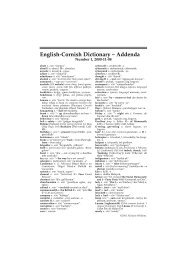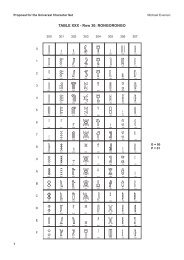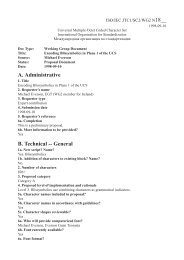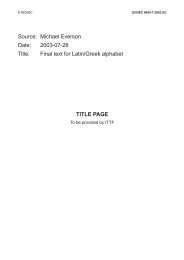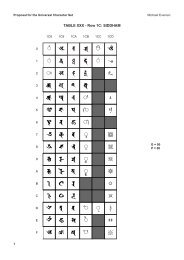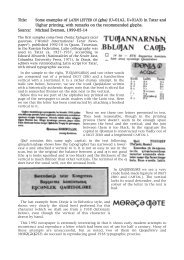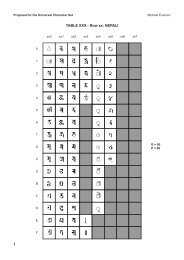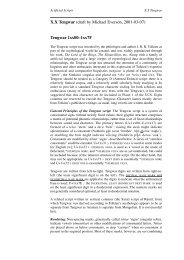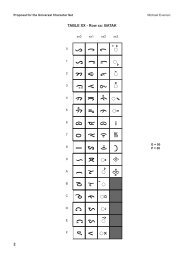Representing Myanmar in Unicode - Evertype
Representing Myanmar in Unicode - Evertype
Representing Myanmar in Unicode - Evertype
Create successful ePaper yourself
Turn your PDF publications into a flip-book with our unique Google optimized e-Paper software.
Advanced Issues<br />
So far we have covered what is expla<strong>in</strong>ed <strong>in</strong> the <strong>Unicode</strong> Standard 3 . In this section we exam<strong>in</strong>e some of the<br />
more difficult areas of the <strong>Myanmar</strong> language <strong>in</strong>clud<strong>in</strong>g some implementation details regard<strong>in</strong>g l<strong>in</strong>e<br />
break<strong>in</strong>g, sort<strong>in</strong>g and render<strong>in</strong>g; further exam<strong>in</strong>ation of the k<strong>in</strong>zi question; contractions and some issues with<br />
respect to Old <strong>Myanmar</strong>.<br />
L<strong>in</strong>e break<strong>in</strong>g<br />
Burmese does not have <strong>in</strong>terword spaces like English. Instead spaces are used to mark phrases. Some<br />
phrases are relatively short (two or three syllables, 1.5em, or 2.3 times the width of U+1000 က) while others<br />
can be quite long (8.5em or 13 times the width of U+1000 က). A common approach to address<strong>in</strong>g l<strong>in</strong>e<br />
break<strong>in</strong>g issues is to adjust the phrase spac<strong>in</strong>g so that a l<strong>in</strong>e breaks at a phrase break. If l<strong>in</strong>e break<strong>in</strong>g is<br />
required with<strong>in</strong> a phrase then there are a number of possible approaches. What is presented here is a slid<strong>in</strong>g<br />
scale of quality of l<strong>in</strong>e break<strong>in</strong>g approaches, start<strong>in</strong>g with the simplest.<br />
Insert Zero-Width Spaces<br />
The simplest approach is to <strong>in</strong>sert a U+200B ZERO WIDTH SPACE (ZWSP) between words <strong>in</strong> a phrase. This<br />
would allow l<strong>in</strong>e breaks between words <strong>in</strong> a phrase. The problem is, though, ensur<strong>in</strong>g that ZWSP characters<br />
are only <strong>in</strong>serted between words. The standard approach is to <strong>in</strong>sert ZWSP between syllables, s<strong>in</strong>ce most<br />
words <strong>in</strong> the languages us<strong>in</strong>g the script are monosyllabic. But the problems occur when ZWSP is<br />
erroneously <strong>in</strong>serted <strong>in</strong>to the middle of a polysyllabic word. Such <strong>in</strong>sertions cause problems for search<strong>in</strong>g<br />
and <strong>in</strong>dex<strong>in</strong>g. Thus ZWSP should only be used where there is certa<strong>in</strong>ty that there is a word break.<br />
Automated Syllable Break<strong>in</strong>g<br />
A better approach uses a purely algorithmic approach to l<strong>in</strong>e break<strong>in</strong>g based on syllable breaks. The outl<strong>in</strong>e<br />
algorithm described here has not been found to fail <strong>in</strong> any of the languages us<strong>in</strong>g the <strong>Myanmar</strong> script. A<br />
syllable break may occur before any cluster (as described <strong>in</strong> the diacritic order<strong>in</strong>g section) so long as the<br />
k<strong>in</strong>zi, asat and stacked slots rema<strong>in</strong> empty <strong>in</strong> the cluster follow<strong>in</strong>g the possible break po<strong>in</strong>t. In reality such an<br />
algorithm requires ref<strong>in</strong>ement, but it still requires no dictionary. For example, sequences of digits should be<br />
kept together.<br />
These same syllable break<strong>in</strong>g rules are used for sort<strong>in</strong>g purposes, with the addition of non-l<strong>in</strong>e break<strong>in</strong>g<br />
syllable breaks, such as those occurr<strong>in</strong>g between the two characters <strong>in</strong> a syllable cha<strong>in</strong>. For example these<br />
phrases show possible <strong>in</strong>ter-syllable l<strong>in</strong>e breaks.<br />
နကာင်နလးနတွ<br />
နကျာင်းကိ ု သွားြက<br />
တယ်။<br />
အိပ်ခန်းတံ ခါးကိ ု<br />
1000 1031 102C 1004 103A | 101C 1031 1038<br />
| 1010 103D 1031 | 1000 103B 1031 102C<br />
1004 103A 1038 | 1000 102D 102F | 101E<br />
103D 102C 1038 | 1000 103C | 1010 101A<br />
103A 104B<br />
1021 102D 1015 103A | 1001 1014 103A 1038<br />
| 1010 1036 | 1001 102B 1038 | 1000 102D<br />
102F<br />
the kids are<br />
go<strong>in</strong>g to<br />
school<br />
to the<br />
bedroom<br />
door<br />
Notice how <strong>in</strong> the second example the word 1010 1036 | 1001 102B 1038 is a s<strong>in</strong>gle word with multiple<br />
syllables. Is there some way, without a dictionary, that we can ensure that the word is not l<strong>in</strong>e broken? There<br />
is a <strong>Unicode</strong> character : U+2060 WORD JOINER. The role of this character is to <strong>in</strong>dicate a non-break<strong>in</strong>g po<strong>in</strong>t<br />
<strong>in</strong> a text. L<strong>in</strong>es should not be broken at that po<strong>in</strong>t. Therefore, if we want to ensure that no l<strong>in</strong>e-break occurs<br />
at the syllable boundary with<strong>in</strong> our poly-syllabic word, we can <strong>in</strong>sert a U+2060 <strong>in</strong>to our data stream between<br />
the two syllables and a render<strong>in</strong>g eng<strong>in</strong>e should not break a l<strong>in</strong>e at that po<strong>in</strong>t. Thus:<br />
အိပ်ခန်းတံ ခါးကိ ု<br />
3 Version 5.1<br />
<strong>Represent<strong>in</strong>g</strong> <strong>Myanmar</strong> <strong>in</strong> <strong>Unicode</strong> Page 9 of 37 Version: 433<br />
1021 102D 1015 103A | 1001 1014 103A 1038<br />
| 1010 1036 2060 1001 102B 1038 | 1000<br />
102D 102F<br />
to the<br />
bedroom<br />
door





